Neotyphodium is a genus of endophytic fungi symbiotic with grasses. It used to contain a number of asexually reproducing species that colonize the leaves of cool-season grasses, but most of them, including the type species N. coenophialum, were merged into the genus Epichloë in 2014. Two species of unclear position were excluded from this treatment:

Dactylis is a genus of Eurasian and North African plants in the bluegrass subfamily within the grass family. Dactylis is native to North Africa, they are found throughout the world, and are an invasive species. They are known in English as cock's-foot or cocksfoot grasses, also sometimes as orchard grasses.

Dactylis glomerata is a species of flowering plant in the grass family Poaceae, commonly known as cock's-foot, orchard grass, or cat grass (due to its popularity for use with domestic cats). It is a cool-season perennial C3 bunchgrass native throughout most of Europe, temperate Asia, and northern Africa.

Epichloë is a genus of ascomycete fungi forming an endophytic symbiosis with grasses. Grass choke disease is a symptom in grasses induced by some Epichloë species, which form spore-bearing mats (stromata) on tillers and suppress the development of their host plant's inflorescence. For most of their life cycle however, Epichloë grow in the intercellular space of stems, leaves, inflorescences, and seeds of the grass plant without incurring symptoms of disease. In fact, they provide several benefits to their host, including the production of different herbivore-deterring alkaloids, increased stress resistance, and growth promotion.
Epichloë aotearoae is a systemic and seed-transmissible symbiont of Echinopogon ovatus, a grass endemic to Australia and New Zealand. It was originally described as a Neotyphodium species in 2002 but moved to Epichloë in 2014.
Epichloë australiensis is a systemic and seed-transmissible symbiont of the grass Echinopogon ovatus. It was originally described as a Neotyphodium species but later transferred to the genus Epichloë.
Epichloë melicicola is a systemic and seed-transmissible endophyte of Melica dendroides and Melica racemosa, grasses endemic to southern Africa. It was described as a Neotyphodium species in 2002 but transferred to the genus Epichloë in 2014.
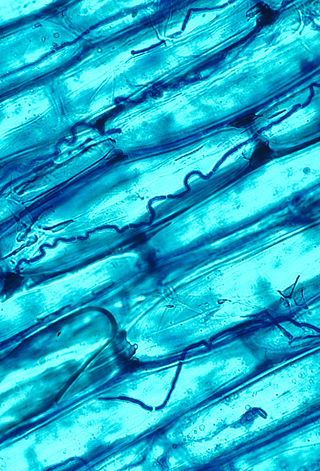
Epichloë coenophiala is a systemic and seed-transmissible endophyte of tall fescue, a grass endemic to Eurasia and North Africa, but widely naturalized in North America, Australia and New Zealand. The endophyte has been identified as the cause of the "fescue toxicosis" syndrome sometimes suffered by livestock that graze the infected grass. Possible symptoms include poor weight gain, elevated body temperature, reduced conception rates, agalactia, rough hair coat, fat necrosis, loss of switch and ear tips, and lameness or dry gangrene of the feet. Because of the resemblance to symptoms of ergotism in humans, the most likely agents responsible for fescue toxicosis are thought to be the ergot alkaloids, principally ergovaline produced by E. coenophiala.

Acremonium is a genus of fungi in the family Hypocreaceae. It used to be known as Cephalosporium.
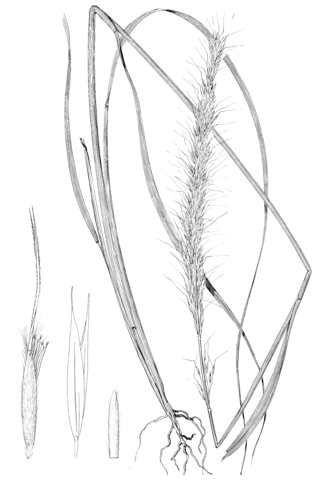
Achnatherum robustum, commonly known as sleepy grass, is a perennial plant in the Poaceae or grass family.
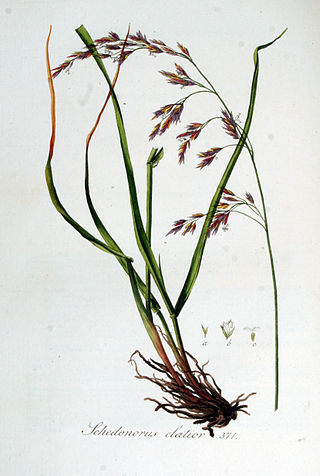
Lolium arundinaceum, tall fescue is a cool-season perennial C3 species of grass that is native to Europe. It occurs on woodland margins, in grassland and in coastal marshes. It is also an important forage grass with many cultivars that used in agriculture and is used as an ornamental grass in gardens, and sometimes as a phytoremediation plant.

A loline alkaloid is a member of the 1-aminopyrrolizidines, which are bioactive natural products with several distinct biological and chemical features. The lolines are insecticidal and insect-deterrent compounds that are produced in grasses infected by endophytic fungal symbionts of the genus Epichloë. Lolines increase resistance of endophyte-infected grasses to insect herbivores, and may also protect the infected plants from environmental stresses such as drought and spatial competition. They are alkaloids, organic compounds containing basic nitrogen atoms. The basic chemical structure of the lolines comprises a saturated pyrrolizidine ring, a primary amine at the C-1 carbon, and an internal ether bridge—a hallmark feature of the lolines, which is uncommon in organic compounds—joining two distant ring carbons. Different substituents at the C-1 amine, such as methyl, formyl, and acetyl groups, yield loline species that have variable bioactivity against insects. Besides endophyte–grass symbionts, loline alkaloids have also been identified in some other plant species; namely, Adenocarpus species and Argyreia mollis.

Plant use of endophytic fungi in defense occurs when endophytic fungi, which live symbiotically with the majority of plants by entering their cells, are utilized as an indirect defense against herbivores. In exchange for carbohydrate energy resources, the fungus provides benefits to the plant which can include increased water or nutrient uptake and protection from phytophagous insects, birds or mammals. Once associated, the fungi alter nutrient content of the plant and enhance or begin production of secondary metabolites. The change in chemical composition acts to deter herbivory by insects, grazing by ungulates and/or oviposition by adult insects. Endophyte-mediated defense can also be effective against pathogens and non-herbivory damage.
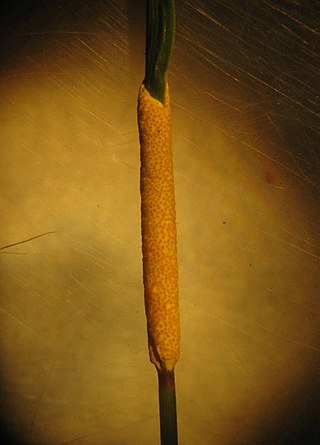
Epichloë typhina is a haploid sexual species in the fungal genus Epichloë. It was originally described as a Sphaeria species. Today, however, it is classified in Epichloë.
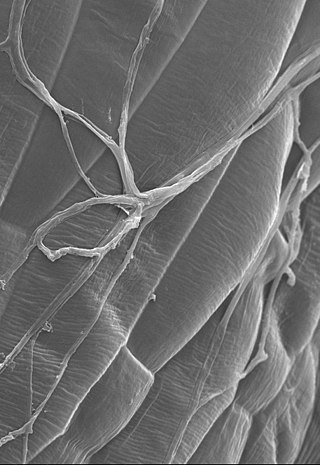
Epichloë festucae is a systemic and seed-transmissible endophytic fungus of cool season grasses.

Epichloë hybrida is a systemic, asexual and seed-transmissible endophyte of perennial ryegrass within the genus Epichloë. An interspecies allopolyploid of two haploid parent species Epichloë typhina and Epichloë festucae var. lolii, E. hybrida was first identified in 1989, recognized as an interspecific hybrid in 1994, but only formally named in 2017. Previously this species was often informally called Epichloë typhina x Epichloë festucae var. lolii, or referenced by the identifier of its most well-studied strain, Lp1. Epichloë hybrida is a symbiont of perennial ryegrass where its presence is almost entirely asymptomatic. The species has been commercialized for the benefits of its anti-insect compounds in a pasture setting, although it is now more commonly used as an experimental model system for studying interspecific hybridization in fungi.
Epichloë gansuensis is a haploid species in the fungal genus Epichloë. The sexual phase has not been observed.
Epichloë funkii is a hybrid asexual species in the fungal genus Epichloë.
Epichloë guerinii is a hybrid asexual species in the fungal genus Epichloë.
Epichloë pampeana is a hybrid asexual species in the fungal genus Epichloë.










